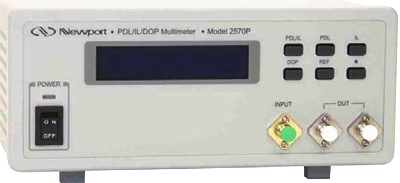
|
|
The Newport 2570P Fiber-Optic PDL/IL/DOP measurement multimeter is a polarization dependent loss (PDL), insertion loss (IL), and degree of polarization (DOP) measurement system with optical power estimate function, which integrates a dynamic polarization controller, optical polarization detection circuit, and a microprocessor based control electronics circuit. The PDL multimeter (2570P) uses a proprietary, deterministic maximum /minimum search scheme that is independent of optical wavelength and the input polarization state of the optical source. This PDL measurement method is also independent of the PDL value to be measured. The 2570P PDL multimeter has three fiber connectors on the front panel: an input connector to accept input from the optical source, and two connectors for DUT connection. It is equipped with a universal connector interface (UCI), which features a male-type adapter top piece that can be removed for direct access to the ferrule end for routine cleaning and maintenance without removing the entire adapter from the panel. Specifications. Input/output fiber type: 9/125 µm SM or compatible. Operating wavelength: 1260 to1650 nm. PDL readout resolution: 0.001 dB (for PDL<6.0 dB), 0.01 dB (for PDL = 6.0 dB). PDL accuracy: ± 0.005 dB (for PDL < 5 dB), ± 0.01 dB (for PDL <15 dB), ± 0.1 dB for PDL >15 dB. PDL repeatability: ± 0.005 dB (for PDL < 5 dB), ± 0.01 dB (for PDL <15 dB), ± 0.1 dB for PDL >15 dB. PDL dynamic range: 0 to 35 dB. Insertion loss (IL) accuracy: ± 0.005 dB for IL < 10 dB. IL repeatability: ± 0.005 dB. IL dynamic range: > 35 dB. Measurement speed: < 0.2 seconds. Optical power accuracy: ± 0.25 dB at 1550 nm. Optical power range: -25 dBm to +6 dBm.
|